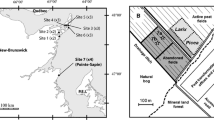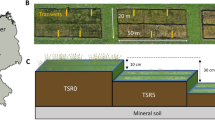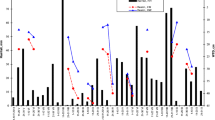Abstract
After 30 years of abandonment, a block-cut peatland near Cacouna, Quebec, Canada, has naturally regenerated Sphagnum mosses on <10% of its area, typical for these disturbed systems. Distinct hydrologic conditions were observed where Sphagnum has successfully recolonized, providing a basis for establishing thresholds that can be targeted by peatland restoration managers. Sites where Sphagnum mosses recolonized were characterized by high water table (mean−24.9±14.3 cm), soil moisture (ϕ) > 50%, and soil-water pressure (Ψ)≥ 100 mb. These hydrologic indicators were spatially organized according to the morphology of block- cut trenches, which typically include raised baulks, shallow ditches, and the convex skag (unused turf) deposits along the central axis of the trench. Topographically low areas like the shallow ditches (D) and lower parts of the skag (LS) adjacent to the ditches maintained ϕ and Ψ > 50% and − 100 mb, respectively, for 100% of the summer period. About 83% of all Sphagnum recolonization that occurred in the study trench did so in these areas. In more raised areas like the mid- and center portion of the skag, ϕ and Ψ eventually fell below these thresholds, and these areas generally did not support Sphagnum, except in a few localized microtopographic depressions in the lower (downslope) end of the trench. While this lower end of the trench had all the Sphagnum species that were present in the trench, even there it was only 38% of the total area. It seems that even short periods of low Ψ may restrict Sphagnum reestablishment in an otherwise favorably wet site.
Similar content being viewed by others
Literature cited
Ahti, E. 1974. Measuring seasonal moisture variation of drained pleatlands by using tensiometers. p. 81–86. In Proceedings, International Symposium on Forest Drainage, Jyväskylä-Oulu, Finland.
Auer, V. 1930. Peat bogs in southeastern Canada. Geological Survey of Canada Memoir 162:1–32.
Beets, C. P. 1992. The relation between the area of open water in bog remnants and storage capacity with resulting guidelines for bog restoration. p. 133–140. In O. M. Bragg, P. D. Hulme, H. A. P. Ingram, and R. A. Robertson (eds.) Peatland Ecosystems and Man: An Impact Assessment. International Peat Society/Department of Biological Sciences, University of Dundee, Dundee, Scotland.
Boelter, D. H. 1965. Hydraulic conductivity of peats. Soil Science 100:227–231.
Campeau, S. and L. Rochefort. 1996. Sphagnum regeneration on bare peat surfaces: field and greenhouse experiments. Journal of Applied Ecology 33:509–608.
Dionne, J.-G. 1977. La Mer de Goldthwait au Québec. Géographie Physique et Quaternaire 31:61–80.
Environment Canada. 1993. Canadian Climate Normals, 1961–1990. Québec. Atmospheric Environment Service, Canadian Climate Program, Environment Canada, Ottawa, Ontario, Canada.
Girard, M. 2000. The natural regeneration of highly disturbed wetlands: Mined peatlands of southern Québec. M.Sc. Thesis Département Geography, Université Laval, Sainte-Foy, Québec, Canada.
Hayward, P. M. and R. S. Clymo. 1982. Profiles of water content and pore size in Sphagnum and peat, and their relation to peat bog ecology. Proceedings of the Royal Society of London B 215:299–325.
Hobbs, N. B. 1986. Mire morphology and the properties and behaviour of some British and foreign peats. Quarterly Journal of Engineering Geology 19:7–80.
Hvorslev, M. J. 1951. Time lag and soil permeability in groundwater observations. U.S. Army Corps of Engineers, Vickburg, MS, USA. Waterways Experimental Station Bulletin 36.
Ingram, H. A. P. 1983. Hydrology. p. 67–158. In A. J. P. Gore (ed.), Ecosystems of the World, Volume 4A, Mires: Swamp, Bog, Fen, and Moor, General Studies. Elsevier, New York, NY, USA.
Ingram, H. A. P. 1978. Soil layers in mires: function and terminology. Journal of Soil Science 29:224–227.
Lavoie, C. and L. Rochefort. 1996. The natural revegetation of a harvested peatland in southern Québec: a spatial and dendroecological analysis. Écoscience 3:101–111.
Lee, H. A. 1962. Surficial Geology of Rivière du Loup—Trois Pistoles Area. Department of Mines and Technical Surveys, Geological Survey of Canada, Québec.
Mannerkoski, H. 1985. Effect of water table fluctuation on the ecology of peat soil. Publications from the Department of Peatland Forestry, University of Helsinki 7:1–190.
National Wetlands Working Group (NWWG). 1988. Wetlands of Canada. Sustainable Development Branch, Environment Canada, Ottawa, Ontario, Canada and Polyscience Publications Inc., Montreal, Quebec, Canada. Ecological Land Classification Series, No. 24.
Päivänen, J. 1973. Hydraulic conductivity and water retention in peat soils. Acta Forestalia Fennica 129:1–70.
Price, J. S. 1996. Hydrology and microclimate of a partly restored cutover bog, Québec. Hydrological Processes 10:1263–1272.
Price, J. S. 1997. Soil moisture, water tension, and water table relationships in a managed cutover bog. Journal of Hydrology 202:21–32.
Price, J. S., L. Rochefort, and S. Campeau. 2000. On the use of trenches to restore cutover peatlands: Hydrology. Restoration Ecology (In Press).
Price, J. S. and S. M. Schlotzhauer. 1999. Importance of shrinkage and compression in determining water storage changes in peat: The case of a mined peatland. Hydrological Processes 13:2591–2601.
Price, J. S., L. Rochefort, and F. Quinty. 1998. Energy and moisture considerations on cutover peatlands: surface microtopography, mulch cover and Sphagnum regeneration. Ecological Engineering 10:293–312.
Priestley, C. H. B. and R. J. Taylor. 1972. On the assessment of surface heat flux and evaporation using large scale parameters. Monthly Weather Review. 100:81–92.
Quinty, F. and L. Rochefort. 1997. Plant re-introduction on a harvested peat bog. p. 133–145. In C. C. Trettin, M. F. Jurgensen, D. F. Grigal, M. F. Gale, and J. K. Jeglum (eds.) Northern Forested Wetlands: Ecology and Management. CRC/Lewis Publishers, Boca Raton, FL, USA.
Rochefort, L., R. Gauthier and D. Lequéré. 1995. Sphagnum regeneration—toward an optimisation of bog restoration. p. 423–434. In B. D. Wheeler, S. C. Shaw, W. J. Fojt and R. A. Robertson (eds.) Restoration of Temperate Wetlands. John Wiley and Sons, Chichester, UK.
Sagot, C. and L. Rochefort. 1996. Tolérance des sphaignes à la dessiccation. Cryptogamie, Bryologie et Lichénologie 17:171–183.
Schlotzhauer, S. M. and J. S. Price. 1999. Soil water flow in a managed cutover peat field, Québec: 1. Field and laboratory investigations. Water Resources Research 35:3675–3683.
Schothorst, C. J. 1977. Subsidence of low moor peat soils in the western Netherlands. Geoderma 17:265–291.
Van Seters, T. E. 1999. Linking the Past to the Present: The Hydrological Impacts of Peat Harvesting and Natural Regeneration on an Abandoned Cut-over Bog, Quebec. MES Thesis. Department of Geography, University of Waterloo, Waterloo, Ontario, Canada.
Van Seters, T. E. and J. S. Price. 2000. The impact of peat harvesting and natural regeneration on the water balance of an abandoned cutover bog, Quebec. Hydrological Processes, in press.
Waddington, J. M. and J. S. Price. Effect of peatland drainage, harvesting and restoration on atmospheric water and carbon exchange. Physical Geography, in press (May 2000).
Waddington, J. M., K. D. Warner, and G. Kennedy 2000. Cut-over peatlands: A persistent source of atmospheric CO2. Submitted to Global Biogeochemical Cycles (September 2000).
Whitehead, G. S. 1999. The hydrological processes influencing the natural regeneration of Sphagnum in a cutover bog after 25 years of abandonment, Quebec. MES Thesis. Department of Geography, University of Waterloo, Waterloo, Ontario, Canada.
Author information
Authors and Affiliations
Corresponding author
Rights and permissions
About this article
Cite this article
Price, J.S., Whitehead, G.S. Developing hydrologic thresholds for Sphagnum recolonization on an abandoned cutover bog. Wetlands 21, 32–40 (2001). https://doi.org/10.1672/0277-5212(2001)021[0032:DHTFSR]2.0.CO;2
Received:
Revised:
Accepted:
Issue Date:
DOI: https://doi.org/10.1672/0277-5212(2001)021[0032:DHTFSR]2.0.CO;2




